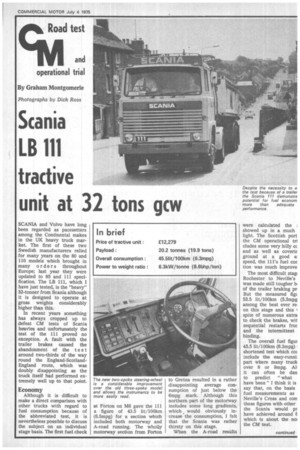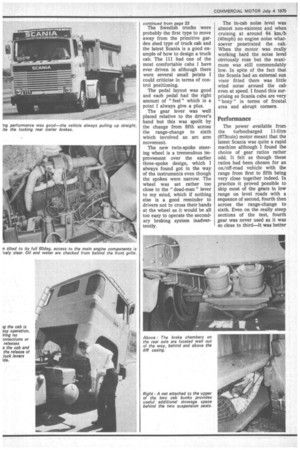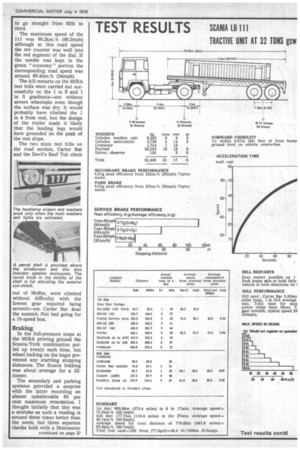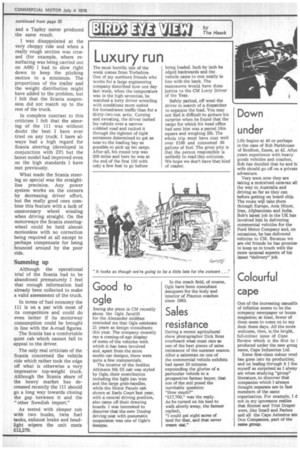Sonia LB 111 tractive unit at 32 tons gcw
Page 35

Page 36

Page 37

Page 39

If you've noticed an error in this article please click here to report it so we can fix it.
SCANIA and Volvo have long been regarded as pacesetters among the Continental makes in the UK heavy truck market. The first of these two Swedish manufacturers relied for many years on the 80 and 110 models which brought in many orders throughout Europe; last year they were updated to 85 and 111 specification. The LB 111, which I have just tested, is the "heavy" 32-tonner from Scania although it is designed to operate at gross weights considerably higher than this.
In recent years something has always cropped up to defeat CM tests of Scania heavies and unfortunately the test of the 111 proved no exception. A fault with the trailer brakes caused the abandonment of the test around two-thirds of the way round the England-ScotlandEngland route, which was doubly disappointing as the truck itself had performed extremely well up to that point.
Economy
Although it is difficult to make a direct comparison with other trucks with regard to fuel consumption because of the abbreviated test, it is nevertheless possible to discuss the subject on an individual stage basis. The first fuel check
The new two-spoke steering-wheel is a considerable improvement over the old three-spoke model and allows the instruments to be more easily read.
at Forton on M6 gave the 111 a figure of 43.5 lit/100km (6.5mpg) for a section which included both motorway and A-road running. The wholly motorway section from Forton to Gretna resulted in a rather disappointing average consumption of just below the 6mpg mark. Although this northern part of the motorway includes some long gradients, which, would obviously increase the consumption, I felt that the Scania was rather thirsty on this stage.
When the A-road results were calculated the ; showed up in a much light. The Scottish port the CM operational tri eludes some very hilly cc and as well as coverir ground at a good a speed, the 11 l's fuel cor tion was much improve The most difficult stag' Rochester to Neville's was made still tougher hi of the trailer braking pr But the measured figt 53.5 lit/100km (5.3mpg among the best ever re, on this stage and this spite of numerous extra to check the brakes, wit sequential restarts fror and the intermittent binding.
The overall fuel figut 45.5 lit/100km (6.3mpg) shortened test which cot include the easy-runni. part where many truck over 8 or 9mpg. Al. it can often be dan to predict "what have been" I think it is say that, on the basis fuel measurements as Neville's Cross and corr these figures with other the Scania would pr have achieved around E which is about the noi the CM test.
continued from page 33
The Swedish trucks were probably the first type to move away from the primitive garden shed type of truck cab and the latest Scania is a good example of how to design a truck cab. The 111 had one of the most comfortable cabs I have ever driven in although there were several small points I could criticise in terms of control positioning.
The pedal layout was good and each pedal had the right amount of " feel " which is a point I always give a plus.
The gear lever was well placed relative to the driver's hand but this was spoilt by the change from fifth across the range-change to sixth which involved an arc arm movement.
The new twin-spoke steering wheel is a tremendous improvement over the earlier three-spoke design, which I always found got in the way of the instruments even though the spokes were narrow. The wheel was set rather too close to the " dead-man " lever to my mind, which if nothing else is a good reminder to drivers not to cross their hands at the wheel as it would be all too easy to operate the secondary braking system inadvertently. The in-cab noise level was almost non-existent and when cruising at around 64 km/h (40mph) no engine noise whatsoever penetrated the cab. When the motor was really working hard the noise level obviously rose but the maximum was still commendably low. In spite of the fact that the Scania had an external sun visor fitted there was little wind noise around the cab even at speed. I found this surprising as Scania cabs are very " boxy " in terms of frontal area and abrupt corners.
Performance
The power available from the turbocharged 11-litre (673cuin) motor meant that the latest Scania was quite a rapid machine although I found the choice of gear ratios rather odd, It felt as though these ratios had been chosen for an on/off-road vehicle with the range from first to fifth being very close together indeed. In practice it proved possible to skip mast of the gears in low range on level roads with a sequence of second, fourth then across the range-change to sixth. Even on the really steep sections of the test, fourth gear was never used as it was so close to third—it was better to go straight from fifth to third.
The maximum speed of the 111 was 99.2km/h (66,2mph) although at this road speed the rev counter was well into the red segment of the dial. If the needle was kept in the green " economy " portion the corresponding road speed was around 86.4km/h (54mph).
The hill restarts on the MIRA test hills were carried out successfully on the 1 in 6 and 1 in 5 gradients-not without severe wheelspin even though the surface was dry. It would probably have climbed the 1 in 4 from rest, but the design of the trailer made it likely that the landing legs would have grounded on the peak of the test slope.
The two main test hills on the road section, Carter Bar and the Devil's Beef Tub climb A parcel shelf is provided above the windscreen and this also includes speaker enclosures. The round knob in the middle of the shelf is for adjusting the exterior sun-shield.
out of Moffat, were climbed without difficulty with the lowest gear required being seventh-on Carter Bar near the summit. Not bad going for a 10-speed box.
Braking
In the full-pressure stops at the MIRA proving ground the Scania/York combination pulled up evenly each time, but wheel locking on the bogie prevented any startling stopping distances. The Scania braking was about average for a 32tonner.
The secondary and parking systems provided a surprise with the latter recording an almost unbelievable 63 per cent maximum retardation. I thought initially that this was a mistake as such a reading is around three times better than the norm, but three separate checks both with a Motometer and a Tapley meter produced the same result.
I was disappointed at the very choppy ride and when a really rough section was crossed (for example, where resurfacing was being carried out on A68) I had to slow right down to keep the pitching motion to a minimum. The proportions of the trailer and the weight distribution might have added to the problem, but I felt that the Scania suspension did not match up to the rest of the truck.
In complete contrast to this criticism I felt that the steering of the ill was without doubt the best I have ever tried on any truck. I have always had a high regard for Scania steering (developed in conjunction with ZF) but the latest model had improved even on the high standards I have met previously.
What made the Scania steering so special was the straightline precision. Any power system works on the corners by decreasing driver effort, but the really good ones combine this feature with a lack of unnecessary wheel winding when driving straight. On the motorways the Scania steeringwheel could be held almost motionless with no correction being required at all except to perhaps compensate for being bounced around by the poor ride.
Summing up
Although the operational trial of the Scania had to be abandoned prematurely I feel that enough information had already been collected to make a valid assessment of the truck.
In terms of fuel economy the Ill is on a par with most of its competitors and could do even better if its motorway consumption could be brought in line with the A-road figures.
The Scania has a comfortable quiet cab which cannot fail to appeal to the driver.
The only real criticism of the Scania concerned the vehicle ride which rather took the edge off what is otherwise a very impressive top-weight truck. Although the Scania share of the heavy market has decreased recently the 111 should go a long way towards closing the gap between it and the "other Swedish import."
As tested with sleeper cab with two bunks, twin fuel tanks, exhaust brake and headlight wipers the unit costs £12,279.




















































































